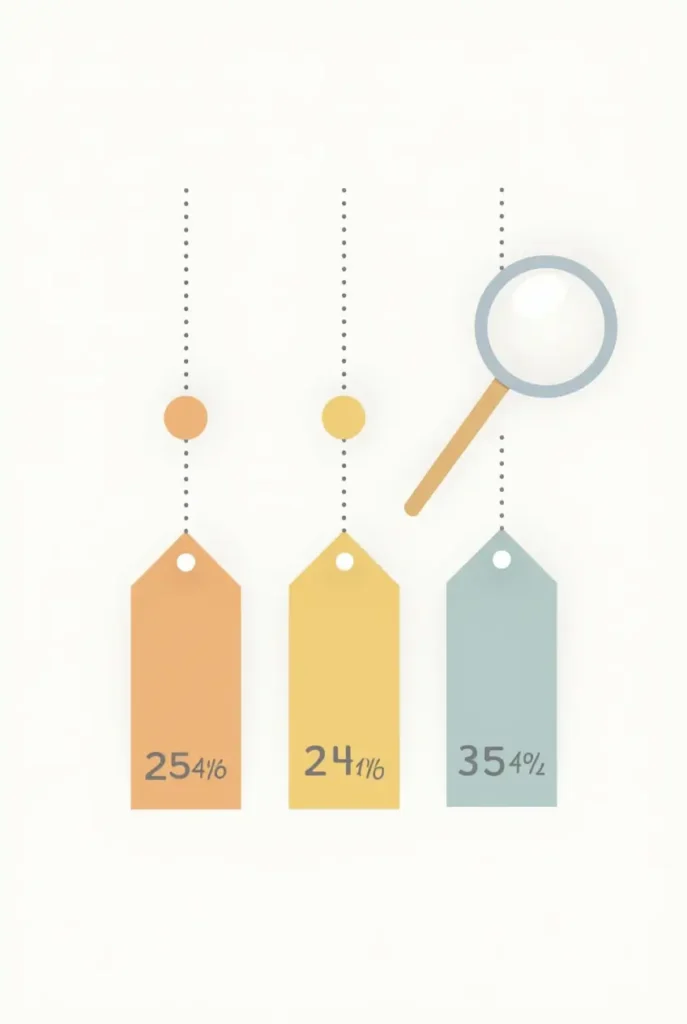Want to slash your monthly expenses without giving up the things you love? You’re in the right place. Smart shopping tips aren’t just about clipping coupons anymore. Today’s savvy shoppers use apps, timing strategies, and insider tricks to save serious cash.
The average American family spends over $5,000 yearly on non-essential purchases. But with the right smart shopping tips, you can cut that number by 30% or more. That’s an extra $1,500 in your pocket every year!
Ready to become a shopping pro? Let’s dive into 12 game-changing strategies that will transform how you spend money.
Table of Contents
12 Essential Smart Shopping Tips Every Savvy Shopper Needs
1. Master the Art of Price Comparison

Never buy anything over $20 without checking at least three different stores first. Smart shopping tips always start with comparison shopping.
Use these tools to compare prices instantly:
- Honey browser extension – Automatically finds coupon codes
- PriceGrabber – Compares prices across major retailers
- Google Shopping – Shows local and online price options
Pro tip: Screenshot prices when you find a good deal. Many stores will price match if you show proof of a lower price elsewhere.
2. Time Your Purchases Like a Pro
Timing is everything in smart shopping. Certain items go on sale during predictable seasons:
Best times to buy:
- Electronics: Black Friday, back-to-school season
- Clothing: End of season clearances (January, August)
- Home goods: White sales in January
- Cars: End of model year (September-November)
Mark your calendar for these sales periods. Planning ahead is one of the most effective smart shopping tips you can use.
3. Use Cashback Apps and Credit Cards

Turn every purchase into a money-making opportunity. Smart shoppers stack multiple cashback methods:
Top cashback apps:
- Rakuten – Up to 10% back at major stores
- Ibotta – Grocery and retail rebates
- Fetch Rewards – Scan receipts for points
Cashback credit cards: Choose cards that give 2-5% back on your most frequent purchases. Just pay off the balance monthly to avoid interest charges.
4. Create a Strategic Shopping List
Random shopping leads to overspending. Smart shopping tips include making detailed lists before you leave home.
List-making strategy:
- Check what you already have at home
- Plan meals around sale items
- Set a spending limit for each category
- Stick to your list (90% of the time)
Studies show shoppers who use lists spend 23% less than those who don’t.
5. Shop Store Brands and Generic Products
Store brands offer the same quality as name brands but cost 20-40% less. This simple switch is one of the easiest smart shopping tips to implement.
Best generic products to try:
- Medications (FDA requires same active ingredients)
- Cleaning supplies
- Basic clothing items
- Pantry staples (flour, sugar, spices)
Start with one or two items. Most people can’t tell the difference in blind taste tests.
6. Master the Art of Bulk Buying
Buying in bulk saves money on items you use regularly. But smart shopping means knowing when bulk buying actually saves money.
Buy in bulk:
- Non-perishable items you use weekly
- Household supplies (toilet paper, detergent)
- Frozen foods with long shelf life
Don’t buy in bulk:
- Perishable items that might spoil
- Products you rarely use
- Items without significant per-unit savings
Calculate the per-unit price to make sure you’re really saving money.
7. Use Store Loyalty Programs Strategically
Most stores offer loyalty programs, but smart shoppers maximize their benefits. These programs are goldmines for implementing smart shopping tips.
Loyalty program hacks:
- Sign up for programs at stores you visit monthly
- Check for bonus point promotions
- Use store credit cards for extra rewards (if you pay them off)
- Stack loyalty rewards with manufacturer coupons
Some programs offer birthday discounts, early sale access, and exclusive member pricing.
8. Shop Your Pantry First
Before heading to the store, “shop” your own pantry and freezer. You might already have ingredients for several meals.
Pantry shopping benefits:
- Reduces food waste
- Saves money on duplicate purchases
- Helps you use items before they expire
- Inspires creative meals with what you have
Make this a weekly habit. It’s one of the smartest shopping tips for busy families.
9. Negotiate and Ask for Discounts
Many stores will negotiate, especially on big-ticket items. Don’t be afraid to ask for a better price.
When to negotiate:
- Electronics and appliances
- Furniture and home goods
- Services (cable, phone, insurance)
- Items with minor damage or missing boxes
How to negotiate:
- Be polite and friendly
- Show competitor prices
- Ask to speak with a manager
- Be willing to walk away
Even a 10% discount can save you hundreds on major purchases.
10. Use Social Media for Deals and Coupons
Follow your favorite brands and stores on social media. They often share exclusive deals and coupon codes with their followers.
Social media deal strategies:
- Follow brands on Instagram and Facebook
- Join store-specific Facebook groups
- Set up deal alerts on Twitter
- Check Instagram stories for flash sales
Many stores offer social media-only discounts that aren’t advertised elsewhere.
11. Buy End-of-Season Items
Purchase next year’s items at the end of each season. This forward-thinking approach is one of the most effective smart shopping tips for big savings.
End-of-season shopping calendar:
- Winter items: February-March (coats, boots, heaters)
- Spring items: May-June (patio furniture, gardening supplies)
- Summer items: August-September (swimwear, outdoor gear)
- Fall items: November-December (Halloween decorations, warm clothes)
You’ll save 50-70% by planning ahead.
12. Set Up Price Alerts and Wish Lists
Let technology do the work for you. Set up price alerts for items you want but don’t need immediately.
Price alert tools:
- Amazon wish lists – Email notifications for price drops
- Google Shopping – Price tracking alerts
- Camelcamelcamel – Amazon price history and alerts
- Slickdeals – Community-driven deal alerts
This patient approach helps you buy items at their lowest prices.
Smart Shopping Apps and Tools Comparison
| Tool | Type | Best Feature | Cost |
|---|---|---|---|
| Honey | Browser Extension | Auto-applies coupon codes | Free |
| Rakuten | Cashback App | Up to 10% cashback | Free |
| Ibotta | Rebate App | Grocery store rebates | Free |
| Fetch Rewards | Receipt Scanning | Points for any receipt | Free |
| Flipp | Coupon App | Digital flyers and price matching | Free |
Pros and Cons of Smart Shopping
Pros:
- Significant savings: Save 20-40% on monthly expenses
- Better budgeting: More money for savings and investments
- Reduced waste: Buy only what you need
- Improved planning: Develops better financial habits
Cons:
- Time investment: Research takes time upfront
- Storage needs: Bulk buying requires storage space
- Temptation: Deal hunting can lead to unnecessary purchases
- App overload: Managing multiple apps and accounts
Savings Potential: Real Numbers
Smart shoppers typically save:
- Groceries: $200-400 per month for a family of four
- Clothing: $100-200 per month by timing purchases
- Electronics: $500-1000 per year by comparing prices
- Household items: $50-100 per month using store brands
Total potential annual savings: $3,000-6,000 for an average family
These smart shopping tips can seriously impact your budget when used consistently.
Best Use Cases for Smart Shopping Strategies
For Busy Families:
- Focus on grocery store apps and loyalty programs
- Buy household essentials in bulk
- Use cashback credit cards for regular purchases
For College Students:
- Master generic brands and store loyalty programs
- Use student discounts and price comparison apps
- Shop end-of-season for next year’s needs
For Retirees:
- Take advantage of senior discounts
- Use newspaper coupons and store flyers
- Shop during off-peak hours for better service
For Tech-Savvy Shoppers:
- Maximize cashback apps and browser extensions
- Set up price alerts for wish list items
- Use social media for exclusive deals
Seasonal Smart Shopping Calendar

Spring (March-May):
- Buy winter clothing and gear
- Shop for gardening supplies before peak season
- Look for spring cleaning product deals
Summer (June-August):
- Purchase back-to-school items early
- Buy spring items on clearance
- Stock up on grilling and outdoor supplies
Fall (September-November):
- Shop for summer items at deep discounts
- Buy Halloween and fall decor after holidays
- Prepare for Black Friday deals
Winter (December-February):
- Take advantage of post-holiday sales
- Buy gift items for next year
- Shop white sales for linens and home goods
Advanced Smart Shopping Tips for Power Savers
Stack Your Savings:
Combine multiple discounts for maximum savings:
- Start with sale prices
- Add store coupons
- Use manufacturer coupons
- Get cashback through apps
- Earn credit card rewards
Price Protection:
Some credit cards offer price protection. If an item goes on sale within 60-90 days of purchase, they’ll refund the difference.
Abandoned Cart Recovery:
Add items to online shopping carts but don’t complete the purchase. Many stores will email you discount codes to complete your order.
Common Smart Shopping Mistakes to Avoid
Buying Just Because It’s On Sale:
A 50% discount on something you don’t need is still 100% waste of money. Stick to your list and actual needs.
Ignoring Return Policies:
Always check return policies before buying. The best deal isn’t worth it if you can’t return a defective item.
Forgetting to Use Rewards:
Don’t let cashback rewards and store credits expire. Set calendar reminders to use them before they expire.
Not Reading the Fine Print:
Some “deals” have hidden costs like shipping fees or membership requirements. Calculate the true total cost.
Smart Shopping for Different Life Stages
New Parents:
- Buy baby items in bulk during sales
- Use store brands for diapers and formula
- Join parenting groups for hand-me-down opportunities
Empty Nesters:
- Downsize bulk purchases to avoid waste
- Focus on quality over quantity
- Take advantage of senior discounts
Young Professionals:
- Invest in quality work clothing during sales
- Use lunch deals and happy hour specials
- Build a professional wardrobe strategically
Technology and Smart Shopping
Artificial Intelligence Shopping:
New AI tools can predict when items will go on sale and suggest the best times to buy specific products.
Voice Shopping Optimization:
Set up voice assistants to add items to your shopping list and compare prices across platforms.
Augmented Reality Try-Ons:
Use AR features to “try on” clothing and makeup before buying online, reducing returns and sizing issues.
Building Long-Term Smart Shopping Habits
Start Small:
Pick 2-3 smart shopping tips to focus on first. Once they become habits, add more strategies gradually.
Track Your Savings:
Keep a savings journal or use an app to track how much you save each month. Seeing the numbers motivates continued effort.
Review and Adjust:
Monthly, review which strategies work best for your lifestyle. Drop techniques that don’t fit your routine.
Share and Learn:
Join online communities focused on smart shopping. Share tips and learn new strategies from other savvy shoppers.
The Psychology of Smart Shopping
Understanding Marketing Tricks:
Stores use psychology to encourage spending. Learn to recognize these tactics:
- End caps aren’t always deals
- Eye-level products cost more
- Limited-time offers create false urgency
Mindful Shopping:
Practice mindful spending by asking yourself three questions before any purchase:
- Do I really need this?
- Will I use this regularly?
- Is this the best price available?
Smart Shopping During Economic Uncertainty
Recession-Proof Strategies:
- Focus on necessities and reduce discretionary spending
- Buy store brands and generic products
- Use every available discount and cashback opportunity
- Build an emergency fund with your savings
Inflation Hedging:
During high inflation periods, stock up on non-perishable items when they’re on sale. Your future self will thank you when prices rise.
Conclusion
These smart shopping tips can transform your finances when you use them consistently. Start with just a few strategies that fit your lifestyle. As they become habits, gradually add more techniques to maximize your savings.
Remember, smart shopping isn’t about being cheap – it’s about being strategic. You’re still buying quality products and enjoying life. You’re just paying less for the same things.
The families who master these smart shopping tips often save enough money to take extra vacations, pay off debt faster, or boost their emergency funds. Every dollar you don’t spend unnecessarily is a dollar that can work toward your financial goals.
Ready to start saving smart today? Pick three tips from this guide and try them this week. Track your savings and watch your money grow. Your wallet will thank you, and you’ll wonder why you didn’t start using these smart shopping tips sooner.
For more money-saving strategies, check out our complete guides on personal finance and budgeting tips. Want to dive deeper into smart shopping? Visit our comprehensive smart shopping resource center for updated deals and strategies.
Start implementing these smart shopping tips today, and join thousands of savvy shoppers who’ve already transformed their spending habits. Your financial future starts with your next purchase decision.

